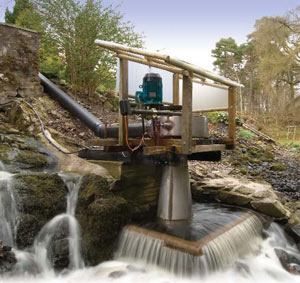Alternative Solutions
MICRO HYDRO GENERATORS
FUEL CELLS
ALTERNATIVE ENERGY STORAGE
ENERGY MONITORING SYSTEMS
Geothermal Collectors
How geothermal energy works.
Geothermal energy can be found virtually anywhere, and it’s one of the most environment-friendly heating and cooling systems available. No matter the climate you live in, the earth absorbs over 40 percent of solar energy, which it then stores beneath its surface.

Is geothermal right for you?
The most popular geothermal recommendations are closed loop systems, with these options:
- Horizontal loops (used when large land surface is available)
- Vertical loops (works in limited space, wherein drilling equipment is used to bore small diameter holes of up to 500 feet deep)
- Lake loops (wherein coils are placed at the bottom of a lake/pond)
Micro Hydro Generators
How hydro-electric generation works.
Hydro-electricity systems convert the energy of moving water into electricity. Small-scale hydro systems don't usually require water storage in the form of a dam or weir. Instead, a portion of a stream or river is temporarily diverted into a pipe system and to the micro-hydro turbine and generator. It's then returned to its source.
Micro and small-scale hydro systems use the force of running water to turn turbine blades, which spin a shaft connected to a generator. These systems are best suited to rural sites, and can be set up wherever water falls from a higher lever to a lower level, such as a waterfall, hillside, stream, or where a reservoir discharges into a river.
The type of turbine required will depend on the ‘head' (the vertical fall) and the flow rate of the water. Pelton wheels are the type of turbine most commonly used for small-scale domestic generation.
Is hydro-electric right for you?
If you have a suitable stream, river, or reservoir, micro-hydro can be the cheapest micro-generation option. The advantage of a micro-hydro system is that it can provide a very consistent and reliable source of electricity compared to other micro-generation technologies.
Distributed (or small-scale) hydro-electric facilities are generally classified into three sizes:
- Micro-hydro is up to 5 kW (kilowatts)
- Mini-hydro is between 5 and 20 kW
- Small commercial hydro is between 20 kW and 10MW (megawatts)

Most micro hydro systems for houses and buildings are less than 5kW, and in many cases less than 1kW.
Contact us to find out how micro hydro energy can work for you.
Fuel Cells
How fuel cells work.
Fuel cells generate electrical power quietly and efficiently, without pollution. Unlike power sources that use fossil fuels, the by-products from an operating fuel cell are heat and water.
With a fuel cell, chemicals constantly flow into the cell so it never goes dead -- as long as there is a flow of chemicals into the cell, the electricity flows out of the cell. Most fuel cells in use today use hydrogen and oxygen as the chemicals.
Are fuel cells right for you?
Fuel cells power buses, boats, trains, planes, scooters, forklifts, even bicycles. There are fuel cell-powered vending machines, vacuum cleaners and highway road signs. Miniature fuel cells provide electricity for cellular phones, laptop computers and portable electronics. Hospitals, credit card centers, police stations, and banks are all using fuel cells to provide power to their facilities. Wastewater treatment plants and landfills are using fuel cells to convert the methane gas they produce into electricity. Telecommunications companies are installing fuel cells at cell phone, radio and 911 towers. The possibilities are endless.
Fuel cells operate silently, so they reduce noise pollution as well as air pollution and the waste heat from a fuel cell can be used to provide hot water or space heating for a home or office.
Contact us to find out how fuel cell energy can work for you.
Alternative Energy Storage
The different types of alternative energy storage.
There are many different types of alternative energy storage and the most common fall under these three categories: capacitors, batteries and flywheels.
Capacitors store their energy in an electrostatic field rather than in chemical form. They consist of two electrodes (plates) of opposite polarity separated by a dielectric or electrolyte. The capacitor is charged by applying a voltage across the terminals which causes positive and negative charges to migrate to the surface of the electrode of opposite polarity.
There are literally hundreds of battery storage types and each works utilizing a unique conversion process. The most notable types are: The Thermal Battery, The Clockwork Battery, The Pneumatic Battery, The Hydraulic Battery, The Magnetic Battery, and The Nuclear Battery.
Modern super flywheels store kinetic energy in a high speed rotating drum which forms the rotor of a motor generator. When surplus electrical energy is available it is used to speed up the drum. When the energy is needed the drum provides it by driving the generator. Modern high energy flywheels use composite rotors made with carbon-fiber materials.
Which one is right for you?
Due to the vast array of alternative energy storage techniques, the best way to assess specific needs are based on levels of storage required and power handling capacity.
Contact us to find out how alternative energy storage can work for you.
Energy Monitoring Systems
How energy monitoring systems work.
Energy monitoring systems (EMS) can increase energy output and create significant efficiencies with all renewable energy techniques. They can be programmed to adjust storage, throughput and even route excess production onto the grid.
Which system is right for you?
Designed to enhance energy efficiency, reduce consumption and provide a more comfortable workspace, EMS options are predicated on the types of renewable energy resources used. Most of them however, provide centralized management, monitoring, automation and analysis of building systems in a browser-based console. Sensors throughout a property can monitor power, air temperature, moisture, air flow, light levels and water consumption.
Contact us to find which energy monitoring system is right for you.
